
Vauxhall Corsa Review

Introduction
The new Corsa had a difficult birth. After years of design work under General Motors ownership, the PSA Group (Peugeot/Citroen) took over and scrapped all that had gone before. The design team then had to take the Peugeot 208 as a base, and turn that into the new Corsa in under two years.
Frankly, no matter how bad or good the car is, the fact it even exists is a credit to the teams working on it.
The old model hadn’t aged well, so this is a huge step forward, but in a world where there are so many competitors, is two years really enough to make a car that can compete with the best?
Review Sections
Select's rating score* - 3.3 / 5
At a Glance
Vauxhall’s designers have played it very safe with the Corsa, so it looks a little bit like lots of other cars. That’s no bad thing for those not keen on attracting attention, but it does leave the car looking a little anonymous. It’s certainly not ugly, but few will give you a second glance.
The sharp-edged front end gives way to a standard supermini silhouette, although the thick C-pillar at the rear adds a bit of design excitement. It fits in well with Vauxhall’s other models, with design cues shared with the Crossland and Grandland, amongst others.
That design theme follows on the inside, where the Corsa is neat if unexciting. It’s like the car has been designed to be as inoffensive as possible, upsetting absolutely nobody.
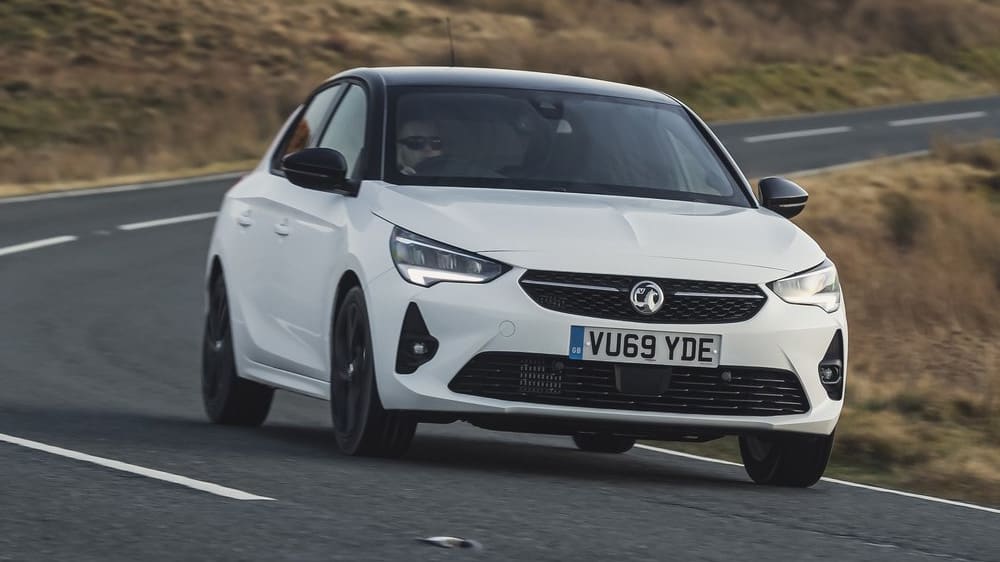
Vauxhall is providing some impressive value across the range, with well-specified SE models right at the bottom rung of the ladder, all the way up to a ludicrously expensive Ultimate Nav model that has everything but a kitchen sink installed. I checked. Most offer excellent value, balancing pricing and equipment well.
The range of engines is limited but suits the car well. There’s just one petrol engine, a 1.2-litre unit, but you can choose between a 75hp option or one with an added turbocharger that produces 100hp. The more frugally minded might look at the 1.5-litre diesel that promises incredible economy.
Vauxhall’s marketing spend is going on promoting the Corsa-e, a pure-electric model with a 136hp motor and a battery pack good for up to 208 miles.
There’s no sign of a hot VXR model, but never say never…
Key Features
Corsa’s key features are less to do with the car itself, and more to do with what buying into the Vauxhall brand can do for you.
No, it’s not going to open up VIP invites to celebrity restaurants, but it will make life living with a car as easy as possible. With 300-odd dealers around the UK, there’ll always be one nearby to deal with any problems or handle servicing requirements. The new owners at PSA Group might merge a few with Peugeot or Citroen dealers, but it’s unlikely the total number will drop significantly.
And the dealers aren’t bad, either. Finishing in the top ten of Auto Express’ annual Driver Power survey, Vauxhall drivers liked the good value for money, polite staff, quick work and high standards.
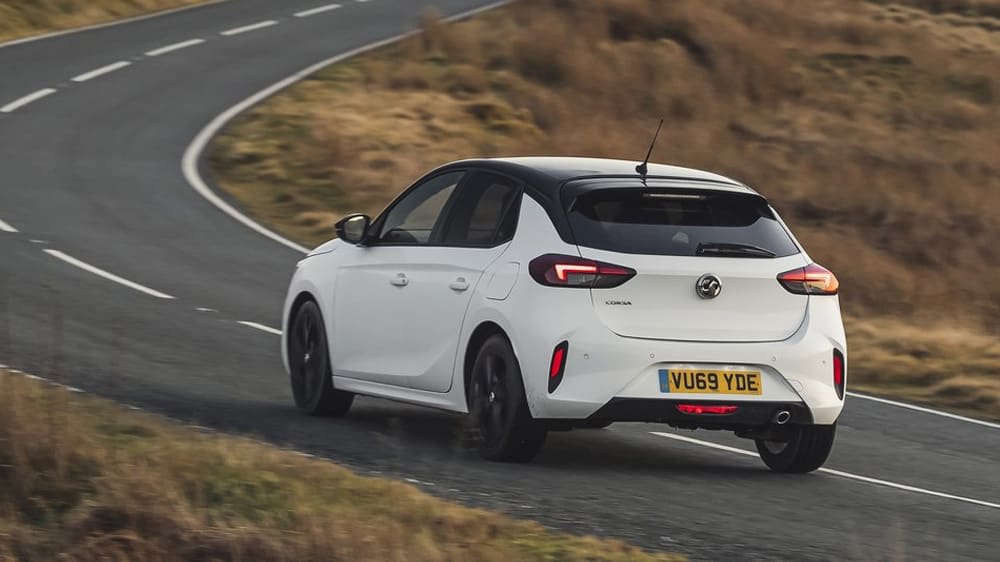
For many, having that kind of backup is worth far more than a 0-62 time that’s a second quicker than the old model, or an infotainment screen that’s an inch bigger than before.
Not that the Corsa forgoes any of that. It’s a well-specified car, loaded with equipment across the entire range, with decent amounts of space throughout and an uncomplicated style that will be enough to keep many people very happy.
Performance & Drive
Despite three engine options, from the 75hp, 1.2-litre petrol to the 102hp, 1.5-litre diesel, there’s only really one you should go for and that’s the one that sits right in the middle of those two.
Choosing the 100hp, turbocharged model provides you with enough poke to keep up with most traffic, thanks to a 0-62mph time of 9.3 seconds. It’s a good engine, smooth and refined enough for most, that’s got the flexibility you need to buzz around town or head out to the motorway. The six-speed manual gearbox is fine, with a long throw but smooth and precise action, but there’s also an eight-speed automatic option to choose from.
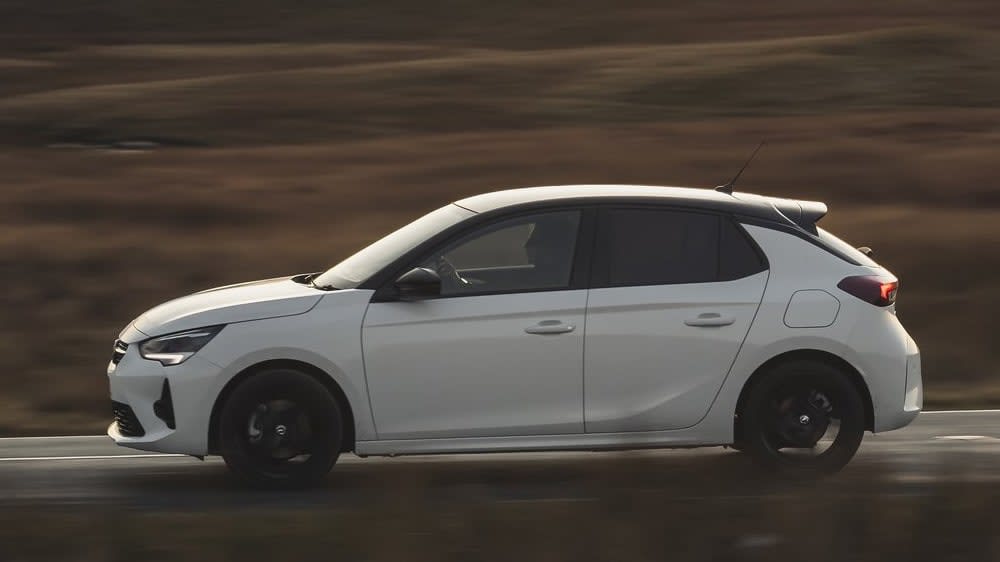
The most powerful engine is the diesel, which also has more torque than it’s siblings, but there’s not a great deal of extra urgency. The figures say otherwise, but it feels like all the power is in a surprisingly tight rev range and, if you stay too low or go too high, there’s little left to move you on. Opting to save a few pennies on the entry-level 75hp engine is a false economy, as you’ll be left with an underpowered, inflexible unit that will only save you the tiniest amount of fuel. For the sake of around £10 a month, save yourself the heartache.
Use what power you have to explore country roads and the Corsa makes a decent effort. It grips well, is stable and well balanced, and won’t do anything to surprise you. The SRi model, despite its sporting pretensions, doesn’t add anything beyond a button to make the steering heavier, so offers no advantage on twistier roads. Other vehicles are more engaging, but the Vauxhall is close enough to warrant attention.
It’s at its best in city environments though, where the super-light steering and diminutive dimensions make it a breeze to navigate around the urban jungle.
Running Costs
Money savers will be looking at that diesel-powered option and think it’s the one to go for. Official fuel figures of up to 70.6mpg are incredible, and not entirely unrealistic. It’s the best in class, and amongst the best on the market, full stop. The flip side is it’s quite expensive, costing around £20 a month extra over the favoured 1.2-litre 100hp petrol model.
That petrol model promises as much as 55mpg anyway, so the gains aren’t necessarily that significant if you stick with the diesel. For company car drivers, the BIK rate is higher on the diesel model, too.
The Corsa-e, powered by nothing but electricity, will be the cheapest model to run. We've yet to drive the new model, but the promise of rapid charging and a 209-mile range is appealing.
All models are covered by a three-year warranty, limited to 60,000 miles. Users will also get 12 months of breakdown cover provided, as well. The battery pack in the Corsa-e is covered for up to eight years or 100,000 miles.
Outside of the Corsa-e, which obviously produces no local emissions at all, the CO2 pumped out by the Corsa is pleasingly sparse. All the petrol engines sit in a range between 93 and 99g/km, meaning they attract a BIK burden of 21-22% for company car users.
The diesel model drops much lower, down to 85g/km, although it’s not RDE2 certified so attracts a higher rate of BIK, up to 24% for 2020/21.
With no hybrid models, vehicle tax rates stay at the standard rate of £150 a year, with a first-year rate of £135 across the entire range.
Interior
There’s absolutely nothing wrong with the Corsa’s interior but, when you park it alongside its Peugeot 208 cousin, you do have to wonder if all the daring design touches went into one car and not the other. The Corsa is as conservative as they come, but it’s thoroughly neat and tidy at the same time.
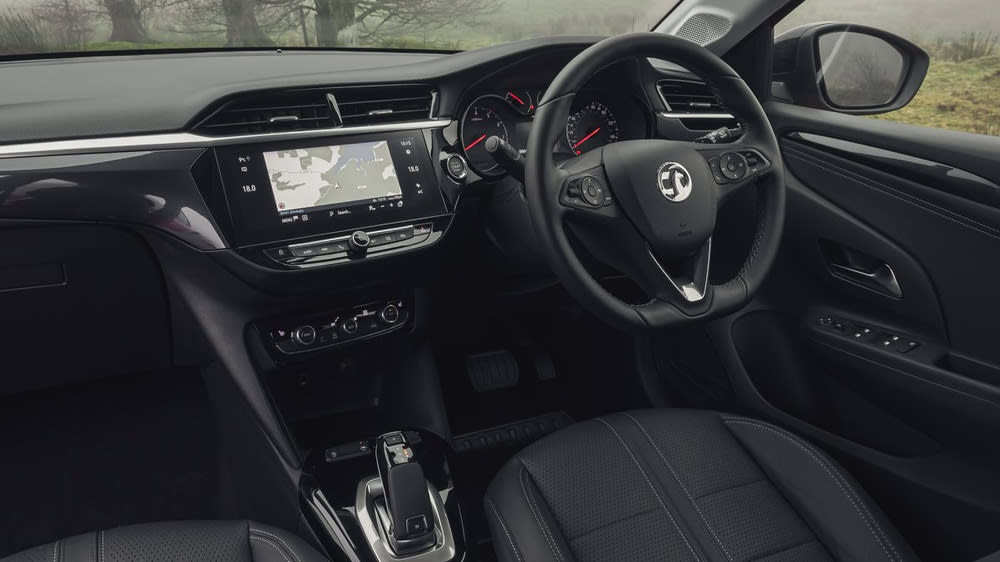
The instrument binnacle ahead of the drier is traditional, with two large dials for revs and speed and two smaller dials for fuel and water temperature. A small digital screen sits in the middle to alert you to anything important.
To the left sits a neatly integrated infotainment screen, complete with much-needed shortcut buttons at the bottom edge and they, in turn, sit above some surprisingly low mounted controls for the heating and ventilation.
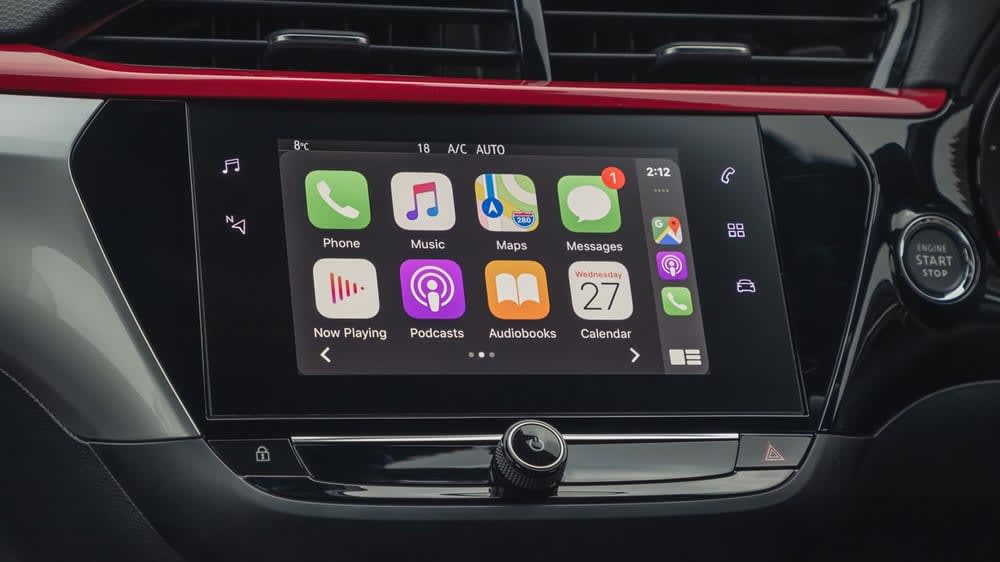
It’s all very well considered, but about as exciting as Theresa May.
Perhaps it’s all intentional on PSA Groups part? If you want sensible slacks and a navy blazer, the Corsa is for you. If you want ripped jeans and a t-shirt tight enough to show what you had for lunch, then the Peugeot 208 might suit. Either way, PSA gets your money.
The shame then is that the Corsa’s fit and finish doesn’t quite live up to the strong and stable design, with the knobs and buttons feeling like they’ve not quite had the attention lavished on them that they need.
The Corsa isn’t wanting for anything in terms of tech, but there’s also nothing there that would get you talking to strangers.
The most obvious tech is the 7.0-inch touchscreen that sits high up on the dashboard. Unlike so many cars, it doesn’t protrude out of the top, like an iPad that’s been glued in as an afterthought. Instead, it’s neatly integrated into an otherwise characterless cabin.
It’s got the standard installations you’d expect, from a DAB+ radio and Bluetooth connectivity to Android Auto and Apple CarPlay. If you’ve got a compatible phone, and most of us do, then it means you can save money and skip the Nav trim levels, using your phone software instead.
If you do use Vauxhall’s software, you should leave some spare time to figure out where everything is, and why some of the screen layouts leave huge swathes of features that can’t be used.
Other cars do these systems better (although it’s no worse than the Peugeot 208’s system) but Vauxhall has been thoughtful and included physical shortcut buttons to get to the most commonly used functions.
Practicality & Boot Space
Front passengers do well in the Corsa, with plenty of headroom for all but the seriously tall, but it’s not that wide so you might find elbows rubbing against doors, or even against your passenger. Rear seat passengers also fare quite well, although face the same width issues.
Storage areas are limited though, with a tiny glovebox and a cubby hole under the armrest. The door pockets are a tad tight, too, but here is a handy phone-sized area ahead of the gear lever that is, conveniently, where you’ll also find the USB and power sockets.
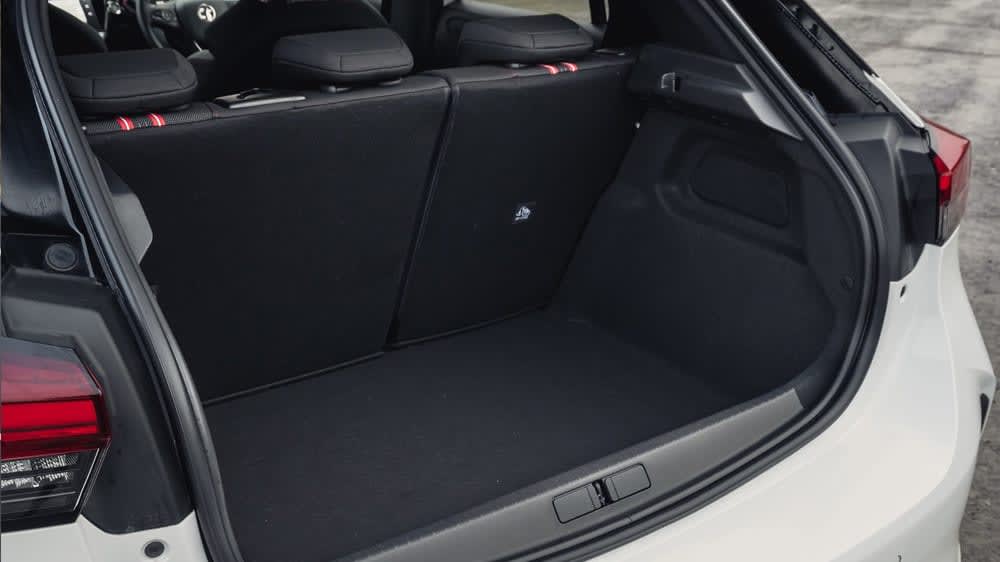
The rear seats split and fold, as you would expect, to open up the boot area. With everything in place, that measures in at 309 litres, extending to 1,118 litres once those seats are down and you’ve loaded everything to the roof. There’s a high lip to lift items over, but the space is a good shape and makes aching it easy. An adjustable height floor might have been a nice touch, but that’s missing from the equipment list.
Safety
At first glance, you might think that the Corsa’s four-star safety rating means it lags behind most of its rivals. However, while Euro NCAP has handed out plenty of five-star ratings to compact cars, there are some controversial reasons as to why the Corsa was docked the last star.
In terms of outright crash protection, the Corsa performed well; adult occupants were well protected, with good or adequate ratings across every type of accident. Side impacts were noted for their strong results, while it scored full marks for child protection. Even pedestrian protection was rated adequate or good.
There’s also a long, long list of technology to help you avoid any accident in the first place, including automatic emergency braking that operates at speeds of up to 53mph, reducing impact speeds at higher levels or bringing the car to a complete stop at urban speeds. There’s cruise control across the whole range that incorporates intelligent speed adaptation; the car reads road signs and adjusts the set speed accordingly. Lane departure warning with lane-keeping assist is standard, and there's even a system to check if the driver is showing signs of fatigue.
Given all that, why does the Corsa score only four stars? Incredibly, it’s because there were only two head restraints on the rear seats of the European specification car Euro NCAP tested. That means some of the test results were declared invalid, despite passing them with flying colours.
UK models come with that centre head restraint and, potentially, would warrant a five-star rating.
Options
There’s no shortage of equipment across the entire Corsa range, from the entry-level SE to the fully-loaded Ultimate Nav model. Confusingly, Vauxhall then split models further, so there’s an SE, SE Nav. SE Premium and SE Nav Premium.
SE models come fitted with a 7.0-inch infotainment touchscreen with DAB radio, Bluetooth connectivity and both Apple CarPlay and Android Auto. There’s also air conditioning, cruise control, LED headlights, electrically adjustable and heated door mirrors and even lane departure warning. The Premium pack adds heated seats and steering wheel, and automatic lights and wipers. Nav packs, rather predictably, add European navigation.
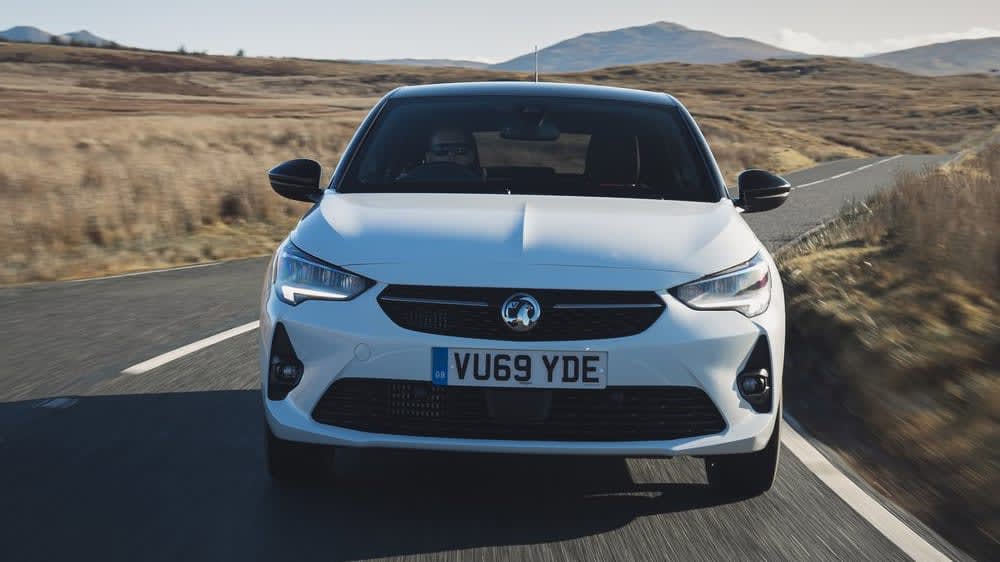
The sporty-looking SRi model adds body styling and sports seats, as well as more LED lights, rear parking sensors and dark tinted windows. The Premium and Nav packs follow much the same path as on the SE.
Elite Nav models bring the Premium and Nav upgrades in as standard equipment but add half-fabric/fake leather trim, automatic high beam and a panoramic reversing camera, amongst other details. The Premium version tops that up with climate control and a 10-inch infotainment screen. Finally, if you happen to have found some wheelbarrows full of cash, the Ultimate Nav has, well, everything. Massage seat? Yes. Perforated leather seat trim? Sure. 17-inch gloss-black diamond-cut alloy wheels? Of course.
The only options left are the paint colour and an optional spare wheel, bringing the list price to (checks notes) a total of £27,455.
Colour choice is the only option you get across to the range, with Vauxhall choosing to abandon an options list and replace them with varying sub-grades. It’s each to their own, of course, but the SRi or SRi Premium models probably strike the best balance between cost and equipment, with the Nav upgrade available for £500 if you need it.
Who Rivals The Vauxhall Corsa?
Almost everybody has a car that could be considered a rival to the Corsa, from the Audi A1 to the Volkswagen Polo, and some of them are spectacularly good.
The most obvious alternative is the Peugeot 208, a car that shares much of its mechanical bits with the Corsa. However, Peugeot has managed to make the 208 more comfortable and added a shed load of style to both the interior and exterior.
The Renault Clio offers a strong driving experience and combines that with similar space and a huge boot. The Volkswagen Polo squeezes in more passenger room and a similarly large boot, and also adds a more upmarket premium sensation.
The biggest seller in the segment is the Ford Fiesta, which is a little bit tighter for space than the Corsa and similarly styled inside, but comes with a sporty driving experience that’s as good as you’ll find.
Verdict & Next Steps
It’s a return to form for the Corsa, but it’s only done enough to catch up its competitors and doesn’t lead them in any area. That there is a sibling vehicle from Peugeot that adds everything the Corsa is missing just adds to the feeling that it’s just too little, too late.
That said, the Corsa benefits from being very well equipped, has some seriously economical engine options, and there’s a dealer around virtually every corner to make servicing and maintenance easy.
Not everybody wants the sharpest handling car or the very latest tech, and would rather have the safety blanket of dealer support within a few miles for a car that does the job satisfactorily.
If the leasing rates are within your budget, I wouldn’t blame you.
Lease price: from £130.27
Looking for the next budget hatchback lease? Take a look at our Mini Hatchback 2020 Review or our latest Volkswagen Golf Review
*Score based on Select’s unique meta score analysis, taking into account the UK’s top six leading independent car website reviews of the Vauxhall Corsa.
**Correct as of 29/09/2020. Based on 9 months initial payment, 8,000 miles over a 48 month lease. Initial payment equivalent to 9 monthly payments or £1,172.45. Ts and Cs apply. Credit is subject to status.


















